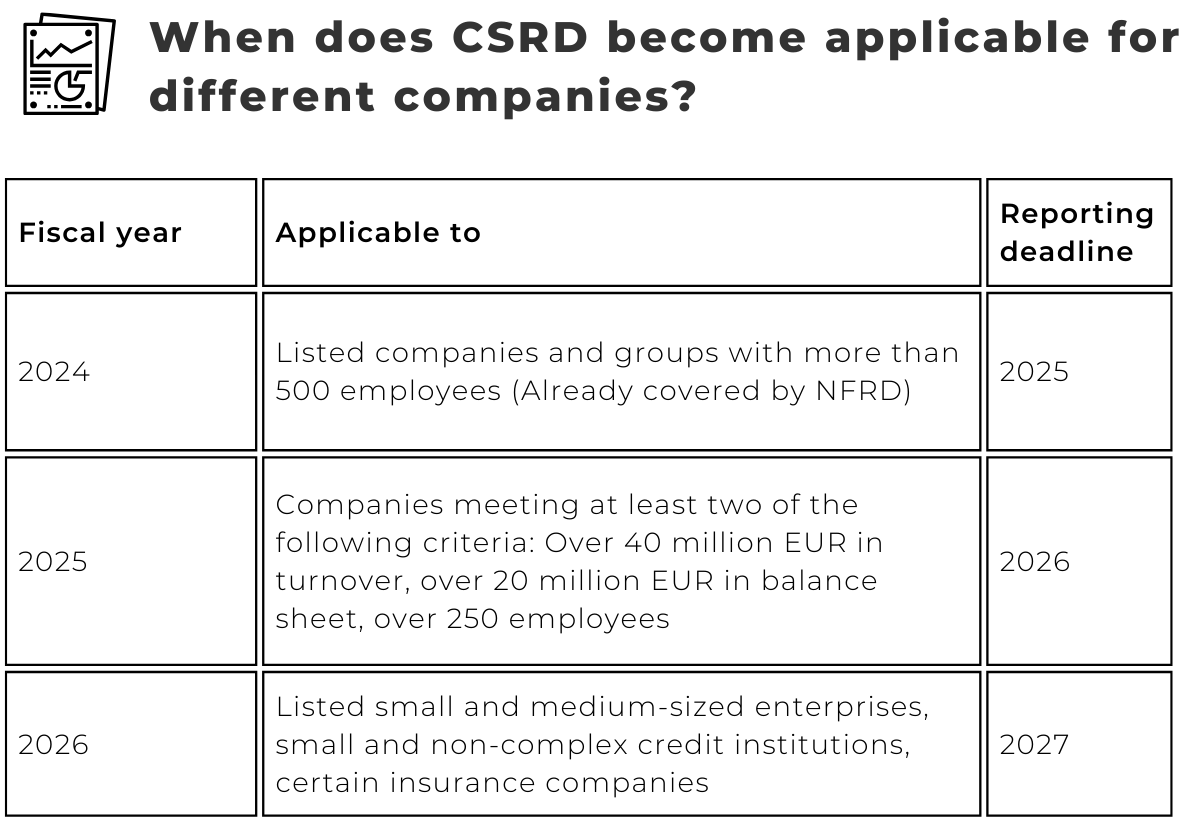Climate reporting and CSRD

Updated at 2025-10-21
The keyword for CSRD (Corporate Sustainability Reporting Directive) work is transparency. Companies need to become more transparent in their sustainability work, and this needs to happen in an organized and structured way - with clear rules. Simply put, the directive describes which companies are obliged to report their sustainability work, and when and how they should do it.

This table provides a clear overview of when different types of companies are required to comply with the Corporate Sustainability Reporting Directive (CSRD) and when they are expected to submit their reports.
It is important to remember that even though the directives currently only cover larger or publicly listed companies, small and medium-sized enterprises are indirectly affected too. 42 % of large companies say they have already had to change suppliers due to insufficient sustainability work*. This makes it more relevant than ever to keep track of one's own sustainability reporting, and by that continue to be an attractive partner for larger actors.
So, what information should be reported?
CSRD is closely linked to another acronym - ESRS (European Sustainability Reporting Standards). This is the common reporting standard for sustainability accounting and primarily indicates what should be reported by companies covered by CSRD - and provides guidelines for exactly how it should be presented.
Together, both CSRD and ESRS cover three different sustainability areas: environmental, social responsibility, and corporate governance. These are in turn broken down into several subcategories. To assess which subcategories are relevant, each company needs to evaluate, among other things, how they impact that specific area.
Climate impact, which is a subcategory within the environment, will in most cases be essential to report. The first step to get a handle on one's emissions is to carry out a climate calculation to continuously follow up on.
Following this, the result from the calculations can be presented in the company’s climate reporting. In short, this means that the company keeps track of its greenhouse gas emissions, discloses where they come from, as well as how they plan to reduce them. This process is a step towards being more environmentally friendly and meeting both market and regulatory requirements, not to mention doing the right thing in a time of escalating climate crisis.
Find out if your company is required to report according to CSRD
In addition to showing companies' sustainability work, reporting according to CSRD offers other benefits such as attracting investors and customers who value sustainability. It also raises awareness of these issues and contributes to more sustainable development. Although there are significant benefits to sustainability reporting, many companies still fail to do this effectively. This is often due to the challenges of measuring results and a reluctance to reveal any shortcomings.
Even if your company is not directly affected by CSRD, it is clear that larger companies will request documentation from their suppliers in order to report themselves. Therefore, it is very important to start having climate data in place.
Our automatic tool helps you collect all the necessary data, whether you are affected by CSRD or not. The calculations are based on data collected through invoices and receipts, categorized according to their climate impact. The emissions are based on the GHG protocol and the figures are presented completely according to ESRS.
Related content
Here you can find articles and pages relevant to this subject.